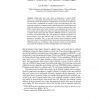875 search results - page 173 / 175 » Reasoning about Knowledge and Continuity |
BMCBI
2010
13 years 6 months ago
2010
Background: Phylogenetic relationships between genes are not only of theoretical interest: they enable us to learn about human genes through the experimental work on their relativ...
CACM
2010
13 years 6 months ago
2010
Exploiting the multiprocessors that have recently become ubiquitous requires high-performance and reliable concurrent systems code, for concurrent data structures, operating syste...
CORR
2010
Springer
13 years 6 months ago
2010
Springer
Natural networks such as those between humans observed through their interactions or biological networks predicted based on various experimental measurements contain a wealth of i...
JAPLL
2008
13 years 6 months ago
2008
In this paper, we study the following basic problem: After having executed a sequence of actions, find a sequence of actions that brings the agent back to the state just before th...
KI
2008
Springer
13 years 6 months ago
2008
Springer
Abstract. Modal logics see a wide variety of applications in artificial intelligence, e.g. in reasoning about knowledge, belief, uncertainty, agency, defaults, and relevance. From ...

